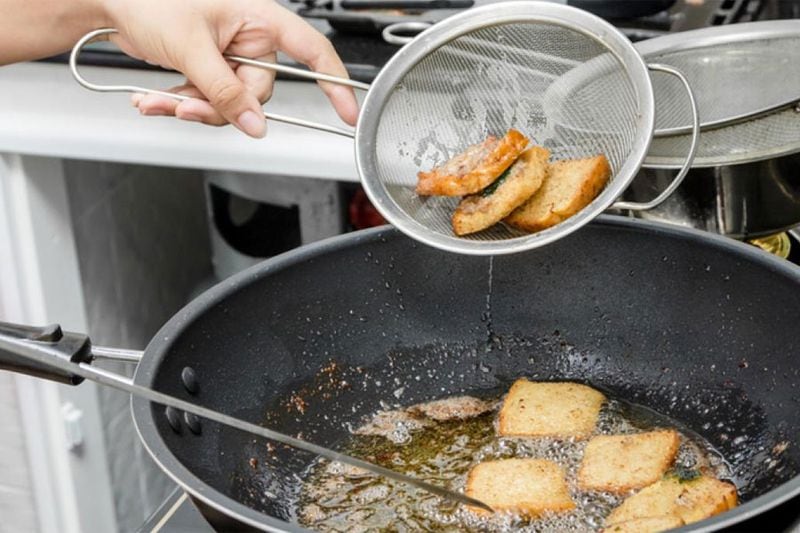After frying, the oil should not be thrown away: firstly because it is expensive and secondly because it is harmful to the environment. Here we show how to filter and save it and how many times it can be reused. And also where to recycle it.
Once the weekend arrives, there’s nothing like indulging in culinary pleasures. Who said fried fish? And with the poor, of course: potatoes, onion and egg, all fried. And while we’re at it: as a starter, a fried seafood empanada?
I don’t know if there’s an unhappy soul on this sad planet who doesn’t have their mouths watering with a menu of this caliber, but after the binge, it’s time to clean up the kitchen and get rid of leftovers and waste. Among them is the huge amount of oil needed to prepare all that frying. And here comes the question: what do you usually do with the leftover oil?
If pouring oil down the drain is your thing, I recommend reassessing the practice. First, because you cause serious damage to the environment: according to various reports, one liter of oil is capable of contaminating between one thousand and 40 thousand liters of water, the equivalent of the annual consumption of one person.
This means that the whole ecosystem that interacts with this water is affected, starting with the rivers, the species that live there, then the land and the vegetation that feeds on the flow, the animals that feed on said vegetation and , finally, the people who consume and/or use any of the “products” that derive from all this affected environment.
On top of all that, dumping the oil down the drain fuels a ticking time bomb. “Due to its different density, oil floats on water and can cause a lot of damage, as it is able to accumulate other wastes and form a bad-smelling mixture. It also prevents water from s ‘oxygenate and helps everything rot inside,’ says chef and science communicator Heinz Wuth.
The case of London
In 2017, London was hit by a huge monster: a gigantic ball of solidified grease that was clogging the sewers of the Whitechapel district. As said, this ball – which they commonly called “fatberg“- was 250 meters long and weighed the equivalent of something like 11 traditional London double-decker buses.
“It’s a monster and it’s going to take a lot of manpower and machinery to remove it because it’s so difficult,” said Matt Rimmer, sewerage manager for Thames Water, the company in charge of the maintenance of the underground network.
The fatberg it consisted of wipes, diapers, sanitary napkins, condoms, and yes, cooking oils and other fats as well. You’d think it was just an unusual situation, but no: four years earlier, London had faced another huge fat ball. And to get rid of it, they had to spend millions of euros. As if to get an idea, the English capital spends around 1.3 million dollars a month to unclog its sewer network.
As London households should be no exception to the mismanagement of their waste, the question is: what to do with the oil?

Can you reuse the oil I made sopaipillas with?
Cooking oil can be reused, even after frying, although it must meet certain conditions for this:
1. Make it into vegetable oil
The oil can have various oleaginous origins. The most common and recommended for cooking are those of plant origin, such as marigold, palm, soy, sesame, rice, corn, almonds, peanuts, canola and, one of the most sought after, olive.
According to Heinz Wuth, the reuse of oil can only be done with those of vegetable origin, because those of animal origin – such as fats, lard or melted butter – generally have other types of components that lead to a shorter lifespan. “For example, an animal-based shortening may contain protein and some water, and these components burn quickly, unlike vegetable oil.”
2. That the oil does not burn
It is common, especially in fried foods, for people to cook at a higher temperature than necessary. How do you know if it’s burning? “When you fry too hot, around 210 or 220 degrees, you get a smoke point — if black or gray smoke comes out of the pan, that’s when the oil is burning,” says Wuth.
The problem with burnt oil is that it poses serious health risks. Oils are made up of long chains of linked fatty molecules which, when heated too much, tend to pull apart, “breaking down and leaving spaces for other substances or chemicals, such as oxygen, to walk in”. This causes the oil to go rancid, and in foods fried or cooked in it, compounds begin to form that can be toxic in the long run.

These are benzopyrenes and acrylamides, two chemicals that have been linked to the development of different types of cancer. “Acrylamide can be produced when vegetables containing the amino acid asparagine, such as potatoes, are heated to high temperatures. It is also part of tobacco smoke,” explains the National Cancer Institute the United States.
If the toxic or cancer risk does not scare you, perhaps the acrid taste of burnt oil, which permeates the food and makes it quite unpleasant.
3. That it is filtered and stored well after use
More and more people are reusing oil in their cooking. However, not all do it correctly.
It’s not that complex. Once the frying is finished, wait for the oil to lose heat and thus avoid burns or other accidents when handling it. Once it is lukewarm or at room temperature, you have to worry about straining it, passing it through a very fine sieve to clean it of the remains of food that it was left with.
“You don’t have to wait an entire day or night to filter it out,” warns Wuth. “Once cold, the sooner it is filtered, the faster any particles or food scraps that continue to burn in the oil and which can become toxic are removed.”
Once the oil has been filtered, you can pour it into a bottle or container – ideally glass – and store it covered, in a cool, dry place out of direct sunlight.
What happens when the oil is stored uncovered and in the sun?
It turns rancid. “It’s something that happens to fats when exposed to oxygen in the air. In this case, it causes the oil to oxidize, leaving it with a very unpleasant pungent taste that carries over to food,” says Wuth.
How many times can the oil be reused?
In theory, cooking oil can be reused two to three times. But there is a detail that must be taken into account: there are certain foods whose flavor is too strong and the oil is usually impregnated with it. Therefore, if you reuse this oil to fry other types of food, it is quite possible that the flavor of the first preparation will pass.
For example, Wuth says, “If you use it to fry fish, a lot of the fat-soluble components will stay in the oil. If I use it later to fry potatoes, they will taste fishy. So that the oil can be reused, but only for the fish. The same can happen with garlic, onion and shellfish. On the other hand, “if the oil is first used to fry potatoes, chicken or meat, there will be no problem reusing it to make broken calzones, for example”.

recycle oil
While the times when you can reuse cooking oil are limited, there are still options to give it a few extra lives: through recycling. In Chile, there are several certified companies that carry out the collection work, to then give it a new destination. One of them is rendering .
With over 15 years of experience and 90 clean points Throughout Chile, Rendering has become one of the most recognized cooking oil recycling companies in the country, providing services to industries as well as the houses .
“Currently, we provide services to more than 15,000 customers in the HORECA segment (hotels, restaurants and casinos)”, explains the general manager, Joaquín Aguirre. Added to this are municipal alliances, with neighborhood associations, building communities and condominiums, among others. “In places where we don’t yet have Clean Points, we collect 20 liters of fuel oil at home,” he adds. The important thing is to have the oil filtered and packaged in a covered container, such as a plastic bottle.
Rendering recycles more than 600 tons of used vegetable oils per month and plans to double this figure within three years. The idea, says Aguirre, is to replicate what happens in countries like Austria and Belgium, where household recycling is 1 liter per capita per year.
What do they do with the oil they collect? “We have a refinery in Lampa, with the capacity to process a thousand tons of oil per month, leaving it in optimal conditions to be exported as the main raw material for the production of biofuel in Europe”, replies Aguirre.
Biofuel production is one of the most common destinations for recycled vegetable oil, but not the only one. Other companies use it as an input for the manufacture of soap, candles, moisturizing creams or exfoliating pastes. And also at home, we can give it a use different from that of gastronomy: how to use it to grease the hinges or the rails of a door or a sliding window, or to protect wooden furniture from the sun and humidity.
In addition to Rendering, there are other companies that collect and intervene for the recycling of oil. If you need it, you need to worry about its national or international certification. It’s a way to make sure the oil has a proper destination and doesn’t end up in a clandestine dump.
And how do you dispose of used oil?
When neither reuse nor recycling are options, all that remains is to throw the oil away. But not down the drain! The ideal, as Heinz Wuth says, would be to have an exclusive deposit, as is the case in certain buildings and communities. The other alternative is to throw it in the kitchen trash or whatever suits you. The important thing in this case is that you do not pour it directly, but put it in a plastic bottle with a lid. “It will still be safer than throwing it down the drain,” says Wuth.
Source: Latercera
I’m Todderic Kirkman, a journalist and author for athletistic. I specialize in covering all news related to sports, ranging from basketball to football and everything in between. With over 10 years of experience in the industry, I have become an invaluable asset to my team. My ambition is to bring the most up-to-date information on sports topics around the world.


